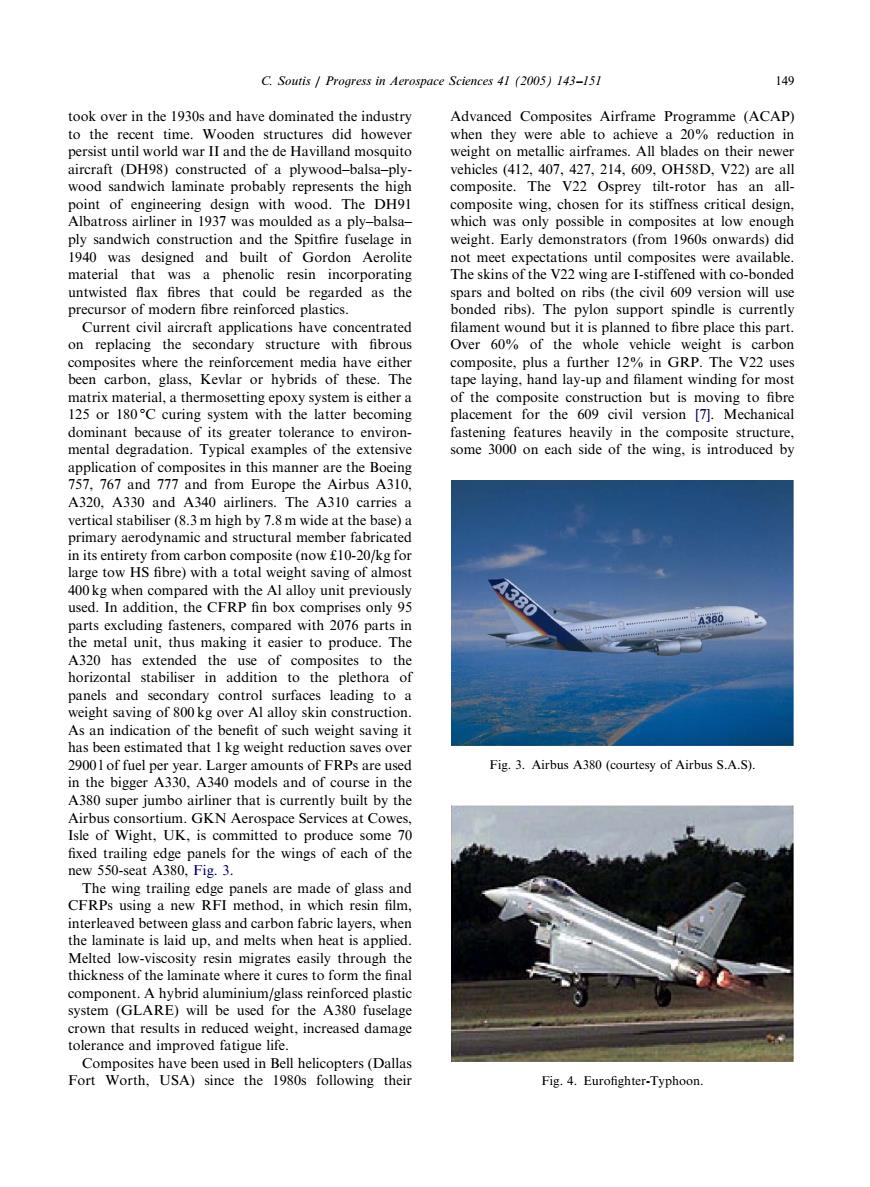正在加载图片...

C.Soutis Progress in Aerospace Sciences 41 (2005)143-151 Advanced composites airframe proo (ACAP to the recent time when they were able to achieve a 20%reduction in (DH98 plywoo 4 V22)are V? point design with wood.The whic was only possible in composites at low enou s (from 1960s onwards) phenolic resin incorpo ating The skins of the V22 wing are I-stiffened with co-bonded regarded as the nt civil aird nd ut it is to fh on replacing the secondary structure with fibrous Over 60%of the whoe vehicleweigh is composites whe th have th in GR he nd of the osite coup a ction but is mo dom of its greater tolerance to environ the compos primary erodynamic and structural member fabricated 400 A1 used.In addition.the CFRP fin box cor only 9 -A380 compared with 2076 parts A320h the the horizontal stabiliser in addition to the plethora of leading to a an indicat tion of the b fit of such w has beene stimated that I kg weight reduction saves ove are Fig.3.Airbus A380(courtesy of Airbus S.A.S in the A 380 suner iumbo airliner that is cu tly built by the new 550-seat A380.Fig.3. d the laminate is laid up.and melts when heat is applie system (GLARE)will be used for the A380 fuselage sites have been used in Bell helic ters (Dallas Fort Worth.USA)since the 1980s following their Fig.4.Eurofighter-Typhoon took over in the 1930s and have dominated the industry to the recent time. Wooden structures did however persist until world war II and the de Havilland mosquito aircraft (DH98) constructed of a plywood–balsa–plywood sandwich laminate probably represents the high point of engineering design withwood. The DH91 Albatross airliner in 1937 was moulded as a ply–balsa– ply sandwichconstruction and the Spitfire fuselage in 1940 was designed and built of Gordon Aerolite material that was a phenolic resin incorporating untwisted flax fibres that could be regarded as the precursor of modern fibre reinforced plastics. Current civil aircraft applications have concentrated on replacing the secondary structure with fibrous composites where the reinforcement media have either been carbon, glass, Kevlar or hybrids of these. The matrix material, a thermosetting epoxy system is either a 125 or 180 1C curing system withthe latter becoming dominant because of its greater tolerance to environmental degradation. Typical examples of the extensive application of composites in this manner are the Boeing 757, 767 and 777 and from Europe the Airbus A310, A320, A330 and A340 airliners. The A310 carries a vertical stabiliser (8.3 m high by 7.8 m wide at the base) a primary aerodynamic and structural member fabricated in its entirety from carbon composite (now £10-20/kg for large tow HS fibre) witha total weight saving of almost 400 kg when compared with the Al alloy unit previously used. In addition, the CFRP fin box comprises only 95 parts excluding fasteners, compared with2076 parts in the metal unit, thus making it easier to produce. The A320 has extended the use of composites to the horizontal stabiliser in addition to the plethora of panels and secondary control surfaces leading to a weight saving of 800 kg over Al alloy skin construction. As an indication of the benefit of such weight saving it has been estimated that 1 kg weight reduction saves over 2900 l of fuel per year. Larger amounts of FRPs are used in the bigger A330, A340 models and of course in the A380 super jumbo airliner that is currently built by the Airbus consortium. GKN Aerospace Services at Cowes, Isle of Wight, UK, is committed to produce some 70 fixed trailing edge panels for the wings of each of the new 550-seat A380, Fig. 3. The wing trailing edge panels are made of glass and CFRPs using a new RFI method, in which resin film, interleaved between glass and carbon fabric layers, when the laminate is laid up, and melts when heat is applied. Melted low-viscosity resin migrates easily through the thickness of the laminate where it cures to form the final component. A hybrid aluminium/glass reinforced plastic system (GLARE) will be used for the A380 fuselage crown that results in reduced weight, increased damage tolerance and improved fatigue life. Composites have been used in Bell helicopters (Dallas Fort Worth, USA) since the 1980s following their Advanced Composites Airframe Programme (ACAP) when they were able to achieve a 20% reduction in weight on metallic airframes. All blades on their newer vehicles (412, 407, 427, 214, 609, OH58D, V22) are all composite. The V22 Osprey tilt-rotor has an allcomposite wing, chosen for its stiffness critical design, which was only possible in composites at low enough weight. Early demonstrators (from 1960s onwards) did not meet expectations until composites were available. The skins of the V22 wing are I-stiffened with co-bonded spars and bolted on ribs (the civil 609 version will use bonded ribs). The pylon support spindle is currently filament wound but it is planned to fibre place this part. Over 60% of the whole vehicle weight is carbon composite, plus a further 12% in GRP. The V22 uses tape laying, hand lay-up and filament winding for most of the composite construction but is moving to fibre placement for the 609 civil version [7]. Mechanical fastening features heavily in the composite structure, some 3000 on eachside of the wing, is introduced by ARTICLE IN PRESS Fig. 3. Airbus A380 (courtesy of Airbus S.A.S). Fig. 4. Eurofighter-Typhoon. C. Soutis / Progress in Aerospace Sciences 41 (2005) 143–151 149